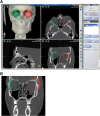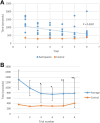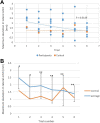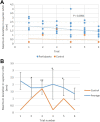Assessment of the Learning Curve for Virtual Surgical Planning in Orbital Fractures
- PMID: 33456685
- PMCID: PMC7797975
- DOI: 10.1177/1943387520923940
Assessment of the Learning Curve for Virtual Surgical Planning in Orbital Fractures
Abstract
Virtual surgical planning (VSP) is becoming more widely used in maxillofacial reconstruction and can be surgeon-based or industry-based. Surgeon-based models require software training but allow surgeon autonomy. We evaluate the learning curve for VSP through a prospective cohort study in which planning times and accuracy of 7 otolaryngology residents with no prior VSP experience were compared to that of a proficient user after a single training protocol and 6 planning sessions for orbital fractures. The average planning time for the first session was 21 minutes 41 seconds ± 6 minutes 11 seconds with an average maximum deviation of 2.5 ± 0.8 mm in the lateral orbit and 2.3 ± 0.6 mm in the superior orbit. The average planning time for the last session was 13 minutes 5 seconds ± 10 minutes and 7 seconds with an average maximum deviation of 1.4 ± 0.5 mm in the lateral orbit and 1.3 ± 0.4 mm in the superior orbit. Novice users reduced planning time by 40% and decreased maximum deviation of plans by 44% and 43% in the lateral and superior orbits, respectively, approaching that of the proficient user. Virtual surgical planning has a quick learning curve and may be incorporated into surgical training.
Keywords: computer aided surgery; maxillofacial trauma; orbital fractures; surgical training; virtual surgical planning.
© The Author(s) 2020.
Conflict of interest statement
Declaration of Conflicting Interests: The author(s) declared no potential conflicts of interest with respect to the research, authorship, and/or publication of this article.
Figures




Similar articles
-
Virtual Surgical Planning of Superior Orbital Rim Fractures in Calvarial and Maxillofacial Trauma.J Oral Maxillofac Surg. 2023 Aug;81(8):1021-1024. doi: 10.1016/j.joms.2023.05.001. Epub 2023 May 9. J Oral Maxillofac Surg. 2023. PMID: 37220870
-
Is Virtual Surgical Planning in Orthognathic Surgery Faster Than Conventional Planning? A Time and Workflow Analysis of an Office-Based Workflow for Single- and Double-Jaw Surgery.J Oral Maxillofac Surg. 2018 Feb;76(2):397-407. doi: 10.1016/j.joms.2017.07.162. Epub 2017 Jul 25. J Oral Maxillofac Surg. 2018. PMID: 28826783
-
Is There a Difference in Cost Between Standard and Virtual Surgical Planning for Orthognathic Surgery?J Oral Maxillofac Surg. 2016 Sep;74(9):1827-33. doi: 10.1016/j.joms.2016.03.035. Epub 2016 Apr 22. J Oral Maxillofac Surg. 2016. PMID: 27181623
-
Virtual Surgical Planning for Mandibular Reconstruction With the Fibula Free Flap: A Systematic Review and Meta-analysis.Ann Plast Surg. 2020 Jan;84(1):117-122. doi: 10.1097/SAP.0000000000002006. Ann Plast Surg. 2020. PMID: 31633539
-
Accuracy of virtual planned surgery versus conventional free-hand surgery for reconstruction of the mandible with osteocutaneous free flaps.Int J Oral Maxillofac Surg. 2020 Sep;49(9):1153-1161. doi: 10.1016/j.ijom.2020.02.018. Epub 2020 Mar 18. Int J Oral Maxillofac Surg. 2020. PMID: 32197824
Cited by
-
Advantages of a Training Course for Surgical Planning in Virtual Reality for Oral and Maxillofacial Surgery: Crossover Study.JMIR Serious Games. 2023 Jan 19;11:e40541. doi: 10.2196/40541. JMIR Serious Games. 2023. PMID: 36656632 Free PMC article.
-
Primary Orbital Reconstruction with Selective Laser Melting (SLM) of Patient-Specific Implants (PSIs): An Overview of 96 Surgically Treated Patients.J Clin Med. 2022 Jun 11;11(12):3361. doi: 10.3390/jcm11123361. J Clin Med. 2022. PMID: 35743432 Free PMC article.
-
Computer assistance in modern craniomaxillofacial surgery.Innov Surg Sci. 2023 Sep 28;8(3):135-136. doi: 10.1515/iss-2023-2002. eCollection 2023 Sep. Innov Surg Sci. 2023. PMID: 38077489 Free PMC article. No abstract available.
References
-
- Strong EB, Fuller SC, Wiley DF, Zumbansen J, Wilson MD, Metzger MC. Preformed vs intraoperative bending of titanium mesh for orbital reconstruction. Otolaryngol Head Neck Surg. 2013;149(1):60–66. - PubMed
-
- Bell RB, Markiewicz MR. Computer-assisted planning, stereolithographic modeling, and intraoperative navigation for complex orbital reconstruction: a descriptive study in a preliminary cohort. J Oral Maxillofac Surg. 2009;67(12):2559–2570. - PubMed
-
- Zweifel DF, Simon C, Hoarau R, Pasche P, Broome M. Are virtual planning and guided surgery for head and neck reconstruction economically viable? J Oral Maxillofac Surg. 2015;73(1):170–175. - PubMed
